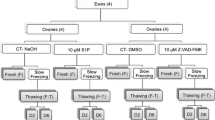Abstract
Significant follicle loss from frozen ovarian grafts is unavoidable. The authors evaluated the protective effects of the antiapoptotic agent sphingosine-1-phosphate (S1P) on vitrified ovarian grafts. Three-week-old sexually immature female FVB mice were divided into 4 groups, fresh, control without S1P, 0.5 mmol/L S1P, and 2 mmol/L S1P. The ovaries were pretreated with S1P for 1 hour and then cryopreserved by modified vitrification. The frozen–thawed ovaries were autotransplanted under the back muscles of mice for 10 days. Expression of apoptosis-related genes encoding caspase 3 and c-Myc was analyzed in the vitrified ovaries and 10 days after transplantation using real-time quantitative polymerase chain reaction. To quantify the ovarian reserve, anti-Müllerian hormone (AMH) levels and follicles were measured in the 10-day vitrified ovarian grafts. Caspase 3 and c-Myc messenger RNA did not differ significantly in the 4 groups after vitrification but was significantly upregulated in the control group after transplantation. The AMH levels and primordial follicle pool were significantly higher in the S1P-treated groups than in the control group but lower than that in the fresh group. The S1P protects vitrified ovarian grafts from ischemic reperfusion injury rather than from vitrification-associated process.
Similar content being viewed by others
References
Nisolle M, Casanas-Roux F, Qu J, Motta P, Donnez J. Histologic and ultrastructural evaluation of fresh and frozen-thawed human ovarian xenografts in nude mice. Fertil Steril. 2000;74(1): 122–129.
Chian RC, Gilbert L, Huang JY, et al. Live birth after vitrification of in vitro matured human oocytes. Fertil Steril. 2009;91(2):372–376.
Radford JA, Lieberman BA, Brison DR, et al. Orthotopic reimplantation of cryopreserved ovarian cortical strips after high-dose chemotherapy for Hodgkin’s lymphoma. Lancet. 2001; 357(9263): 1172–1175.
Hancke K, Walker E, Strauch O, Göbel H, Hanjalic-Beck A, Denschlag D. Ovarian transplantation for fertility preservation in a sheep model: can follicle loss be prevented by antiapoptotic sphingosine-1-phosphate administration? Gynecol Endocrinol. 2009;25(12):839–843.
Wallace WH, Anderson RA, Irvine DS. Fertility preservation for young patients with cancer: who is at risk and what can be offered? Lancet Oncol. 2005;6(4):209–218.
Lobo RA. Potential options for preservation of fertility in women. N Engl J Med. 2005;353(1):64–73.
Xu M, Pavone ME, Woodruff T. Fruitful progress to fertility: preserving oocytes from chemodestruction. Nat Med. 2011; 17(12):1562–1563.
Steponkus PL, Myers SP, Lynch DV, et al. Cryopreservation of Drosophila melanogaster embryos. Nature. 1990;345(6271):170–172.
Gonfloni S, Di Telia L, Caldarola S, et al. Inhibition of the c-Abl-TAp63 pathway protects mouse oocytes from chemotherapyinduced death. Nat Med. 2009;15(10):1179–1185.
Oktay K, Buyuk E, Libertella N, Akar M, Rosenwaks Z. Fertility preservation in breast cancer patients: a prospective controlled comparison of ovarian stimulation with tamoxifen and letrozole for embryo cryopreservation. J Clin Oncol. 2005;23(19):4347–4353.
Silber SJ. Ovary cryopreservation and transplantation for fertility preservation. Mol Hum Reprod. 2012;18(2):59–67.
Gosden RG, Baird DT, Wade JC, et al. Restoration of fertility to oophorectomized sheep by ovarian autografts stored at −196 degrees C. Hum Reprod. 1994;9(4):597–603.
Baird DT, Webb R, Campbell BK, Harkness LM, Gosden RG. Long-term ovarian function in sheep after ovariectomy and transplantation of autografts stored at −196°C. Endocrinology. 1999;140(1):462–471.
Morita Y, Perez GI, Paris F, et al. Oocyte apoptosis is suppressed by disruption of the acid sphingomyelinase gene or by sphingosine-1-phosphate therapy. Nat Med. 2000;6(10):1109–1114.
Hancke K, Strauch O, Kissel C, Göbel H, Schäfer W, Denschlag D. Sphingosine 1-phosphate protects ovaries from chemotherapy-induced damage in vivo. Fertil Steril. 2007;87(1):172–177.
Cuvillier O, Pirianov G, Kleuser B, et al. Suppression of ceramide-mediated programmed cell death by sphingosine-1-phosphate. Nature. 1996;381(6585):800–803.
Ogretmen B, Hannun YA. Biologically active sphingolipids in cancer pathogenesis and treatment. Nat Rev Cancer. 2004;4(8):604–616.
Spiegel S, Kolesnick R. Sphingosine 1-phosphate as atherapeutic agent. Leukemia. 2002; 16(9): 1596–1602.
Perry DK. Ceramide and apoptosis. Biochem Soc Trans. 1999; 27(4):399–404.
Lane M, Gardner DK. Vitrification of mouse oocytes using a nylon loop. Mol Reprod Dev. 2001;58(3):342–347.
Yeoman RR, Wolf DP, Lee DM. Coculture of monkey ovarian tissue increases survival after vitrification and slow-rate freezing. Fertil Steril. 2005;83(suppl 1):1248–1254.
Sugimoto M, Maeda S, Manabe N, Miyamoto H. Development of infantile rat ovaries autotransplanted after cryopreservation by vitrification. Theriogenology. 2000;53(5): 1093–1103.
Migishima F, Suzuki-Migishima R, Song SY, et al. Successful cryopreservation of mouse ovaries by vitrification. Biol Reprod. 2003;68(3):881–887.
Salehnia M, Abbasian Moghadam E, Rezazadeh Velojerdi M. Ultrastructure of follicles after vitrification of mouse ovarian tissue. Fertil Steril. 2002;78(3):644–645.
Salehnia M, Sheikhi M, Pourbeiranvand S, Lundqvist M. Apoptosis of human ovarian tissue is not increased by either vitrification or rapid cooling. Reprod Biomed Online. 2012;25(5):492–499.
Ebrahimi B, Valojerdi MR, Eftekhari-Yazdi P, Baharvand H. In vitro maturation, apoptotic gene expression and incidence of numerical chromosomal abnormalities following cryotop vitrification of sheep cumulus-oocyte complexes. J Assist Reprod Genet. 2010; 27(5):239–246.
Abir R, Fisch B, Jessel S, Felz C, Ben-Haroush A, Orvieto R. Improving posttransplantation survival of human ovarian tissue by treating the host and graft. Fertil Steril. 2011 ;95(4): 1205–1210.
Friedman O, Orvieto R, Fisch B, et al. Possible improvements in human ovarian grafting by various host and graft treatments. Hum Reprod. 2012;27(2):474–482.
Okun E, Arumugam TV, Tang SC, et al. The organotellurium compound ammonium trichloro(dioxoethylene-0,0′) tellurate enhances neuronal survival and improves functional outcome in an ischemic stroke model in mice. J Neurochem. 2007;102(4):1232–1241.
Hammad SM, Al Gadban MM, Semler AJ, Klein RL. Sphingosine 1-phosphate distribution in human plasma: associations with lipid profiles. J Lipids. 2012;2012:1–8.
Paris F, Perez GI, Fuks Z, et al. Sphingosine 1-phosphate preserves fertility in irradiated female mice without propagating genomic damage in offspring. Nat Med. 2002;8(9):901–902.
Chen SU, Chien CL, Wu MY, et al. Novel direct cover vitrification for cryopreservation of ovarian tissues increases follicle viability and pregnancy capability in mice. Hum Reprod. 2006; 21(111):2794–2800.
Suzuki N, Hashimoto S, Igarashi S, et al. Assessment of long-term function of heterotopic transplants of vitrified ovarian tissue in cynomolgus monkeys. Hum Reprod. 2012;27(8):2420–2429.
Author information
Authors and Affiliations
Corresponding author
Rights and permissions
About this article
Cite this article
Tsai, YC., Tzeng, CR., Wang, CW. et al. Antiapoptotic Agent Sphingosine-1-Phosphate Protects Vitrified Murine Ovarian Grafts. Reprod. Sci. 21, 236–243 (2014). https://doi.org/10.1177/1933719113493515
Published:
Issue Date:
DOI: https://doi.org/10.1177/1933719113493515




